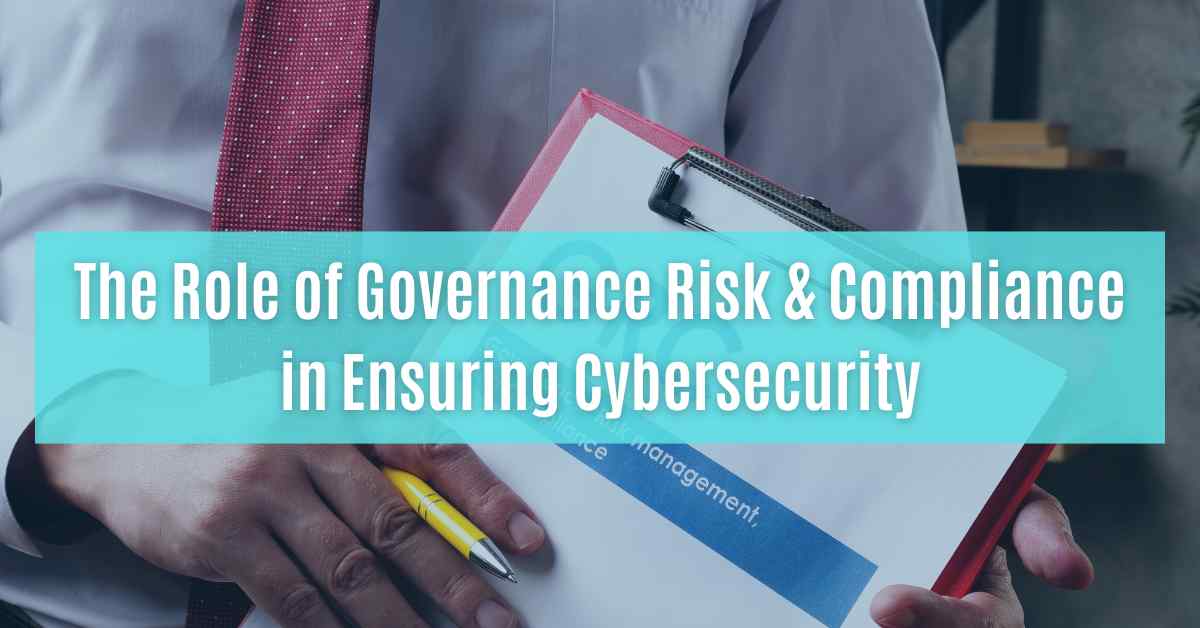In the current digital environment, where businesses significantly rely on connectivity and technology, guaranteeing cybersecurity has become crucial.
Cyberattacks and data breaches can place sensitive information at serious risk of confidentiality, integrity, and availability, hurting finances, reputation, and the law. Organizations must implement efficient governance, risk, and compliance (GRC) policies to reduce these risks, as these strategies are crucial to protecting their digital assets.
The methods, frameworks, and systems organizations use to manage possible risks, conform to regulations and industry standards, and maintain good governance practices are called governance risk and compliance.
To decrease vulnerabilities and strengthen an organization against cyber attacks, GRC includes identifying, evaluating, and managing risks, installing controls and policies, and constructing compliance frameworks.
There are several facets to the Role of Governance Risk and Compliance in Ensuring Cybersecurity. The first step is to set up a robust governance framework to control cybersecurity risks throughout the organization.
To maintain cybersecurity as a top priority across the organization, effective governance structures assign roles and duties, set cybersecurity objectives, and implement suitable risk management procedures.
Table of Contents
What is the Role of Governance Risk and Compliance in Ensuring Cybersecurity?

1. Establishing Policies and Procedures
Establishing guidelines for cybersecurity practices within an organization is one of the primary duties of governance, risk, and compliance (GRC). This entails creating and implementing cybersecurity policies that describe the company’s strategy for managing cybersecurity risks and safeguarding its digital assets.
Cybersecurity policies provide clear standards and expectations for protecting data, networks, and information systems.
These regulations address various topics, including staff security awareness, data classification, and access controls. They aid in defining the organization’s cybersecurity goals and ensure they comply with legal and industry best practices.
Developing risk assessment and mitigation protocols is another aspect of the Role of Governance Risk & Compliance in Ensuring Cybersecurity. Risk analyses locate and examine potential cybersecurity threats unique to the organization’s environment, allowing for an educated choice of risk-reduction measures.
The effect and possibility of various risks are evaluated by GRC teams in collaboration with IT and cybersecurity experts, who also look for vulnerabilities and potential control gaps. Organizations can create the necessary controls and processes to reduce these risks by first recognizing them.
2. Ensuring Regulatory Compliance
Organizations must adhere to all applicable laws and standards to show their dedication to cybersecurity. GRC is essential in ensuring businesses stay current on cybersecurity laws and standards relevant to their sector or region.
GRC experts regularly monitor the regulatory environment to spot modifications or new cybersecurity-related regulations. Regulations about data privacy, such as the General Data Protection Regulation (GDPR) or the California Consumer Privacy Act (CCPA), as well as rules unique to particular industries, like the Payment Card sector Data Security Standard (PCI DSS) for the payment card sector, are included in this.
GRC teams can assist organizations in modifying their cybersecurity procedures to satisfy compliance obligations by being educated about this legislation.
Another essential part of the Governance Risk & Compliance is the implementation of controls to satisfy compliance obligations.
GRC teams work with IT and cybersecurity experts to determine the controls required to adhere to regulatory standards and deploy those controls throughout the organization.
These controls include access controls, encryption protocols, network monitoring, and incident response protocols. For these controls to be effective and compliant with legal requirements, GRC teams also oversee regular testing and monitoring.
3. Conducting Risk Assessments and Audits
Conducting risk assessments and audits is one of the crucial duties of the Role of Governance Risk and Compliance in Ensuring Cybersecurity. These actions aid in locating and assessing cybersecurity vulnerabilities in the company’s infrastructure, systems, and procedures.
To estimate the risk associated with each designated location, prospective threats, vulnerabilities, and impacts are systematically examined.
To evaluate the possibility and potential effects of various risks, such as unauthorized access, data breaches, and system breakdowns, GRC teams collaborate closely with IT and cybersecurity experts.
Organizations can create strategies and controls to minimize these risks by understanding them.
GRC teams are essential in regularly evaluating the efficacy of cybersecurity protections. This comprises assessing if the established controls are well-conceived, effectively implemented, and carrying out their intended functions.
Assessments can include vulnerability scans, penetration tests, and compliance audits to locate control gaps and cybersecurity weak points within the organization.
4. Incident Response and Management
The creation and implementation of incident response plans and processes are crucial to the Role of Governance Risk and Compliance in Ensuring Cybersecurity. The procedures to be followed in the event of a cybersecurity incident, such as a data breach or a network incursion, are outlined in incident response plans.
To define roles and duties, develop communication procedures, and guarantee the availability of relevant resources, GRC teams work in conjunction with IT, cybersecurity, and legal departments.
To create incident response procedures that specify the precise steps to be performed during an occurrence, GRC professionals collaborate closely with incident response teams.
The initial identification and assessment of the incident, the containment and elimination of the danger, the preservation of the evidence, the notification of the pertinent parties, and the recovery and restoration of the impacted systems are common steps taken during these procedures.
Organizations can reduce the impact and possible harm caused by cybersecurity incidents by implementing well-defined incident response policies and procedures.
Benefits of Leveraging the Governance Risk and Compliance in Ensuring Cybersecurity

Organizational cybersecurity must be ensured through governance, risk, and compliance (GRC) practices. Organizations can gain several advantages by utilizing GRC, strengthening their security posture.
1. Enhanced Risk-Taking
Improved risk management is one of the main advantages of Governance Risk and Compliance in Ensuring Cybersecurity. To detect, evaluate, and mitigate possible risks to the organization’s digital assets, GRC teams collaborate closely with IT and cybersecurity experts.
By conducting risk assessments, organizations can better understand their vulnerabilities and the potential effects of cyber threats. This enables them to successfully create and implement the proper checks and safeguards to reduce these risks.
GRC encourages a proactive approach to risk management, assisting businesses in avoiding hazards. GRC teams can discover emerging risks and vulnerabilities by continuously monitoring the cybersecurity landscape and changing the threat landscape, allowing organizations to take preventive action quickly.
This proactive approach to risk management reduces the possibility and consequences of cybersecurity incidents, minimizing monetary losses and reputational harm.
2. Enhanced Compliance And Adherence To Regulations
The increased compliance and adherence to laws is another crucial advantage of Governance Risk and Compliance. GRC teams closely monitor and stay current with pertinent cybersecurity laws, standards, and best practices.
They ensure that the company’s cybersecurity procedures comply with legal mandates, including data protection laws (such as the GDPR and CCPA), industry standards (such as the PCI DSS), and other cybersecurity frameworks.
Organizations can lessen the possibility of regulatory fines by enforcing controls and procedures to comply with regulations.
They can also show their dedication to safeguarding confidential information and client data. Following cybersecurity rules and guidelines also improves an organization’s reputation, fosters stakeholder trust, and provides a competitive edge.
3. Holistic Approach to Cybersecurity
GRC encourages a comprehensive strategy for cybersecurity by fusing governance, risk management, and compliance into a single framework.
Using a comprehensive plan ensures that cybersecurity is taken into account at all organizational levels, as well as across diverse departments and functions.
GRC teams work with critical stakeholders, including senior management, IT, legal, and HR departments, to build cybersecurity governance structures, specify roles and duties, and set specific goals.
This participation from all departments inside the company ensures that cybersecurity is ingrained in the culture and becomes a shared responsibility.
Challenges and Considerations while Implementing Governance Risk and Compliance

1. GRC Incorporation Into Organizational Procedures
Integrating GRC practices into current organizational processes is one of the difficulties organizations encounter while implementing the Role of Governance Risk & Compliance in Ensuring Cybersecurity.
GRC activities should be seamlessly incorporated into multiple departments and business processes to guarantee that cybersecurity is ingrained throughout the organization.
For this integration to be successful, many departments, including IT, cybersecurity, legal, HR, and senior management, must work together and cooperatively.
To make sure that cybersecurity considerations are included in their procedures, decision-making, and daily activities, GRC teams must collaborate closely with these teams.
GRC should be regarded as an integral part of the organization’s risk management procedures rather than a distinct function.
2. Securing Adequate Resources For GRC Initiatives
The proper allocation of resources is necessary to implement GRC practices for cybersecurity. To build and maintain reliable GRC frameworks, organizations must invest in qualified individuals, cutting-edge technologies, valuable tools, and training. Finding sufficient resources, though, might occasionally be a problem.
Resource limitations, such as a lack of funding or qualified personnel in the GRC and cybersecurity domains, may be experienced by GRC teams. This may make it more difficult for the company to create and implement thorough GRC programs.
Organizations must prioritize cybersecurity and provide enough funds to GRC initiatives to meet this problem.
3. Addressing The Dynamic Nature Of Cybersecurity Threats
Cybersecurity threats continuously change as attackers use novel tactics and exploit newly discovered weaknesses. For GRC teams, the evolving nature of cyber threats is a substantial challenge.
To ensure that their GRC practices continue to be effective, they must keep up with the most recent developments in cybersecurity, new risks, and developing legislation.
To discover new threats, GRC teams must regularly undertake assessments, communicate with external industry experts, participate in forums and information-sharing networks, and actively monitor the cybersecurity landscape.
For the organization’s cybersecurity controls to be updated and improved, monitoring the situation and taking appropriate action continuously is essential.
Conclusion
In summary, GRC plays a critical role in ensuring cybersecurity within organizations. Establishing policies and processes, ensuring regulatory compliance, doing risk assessments, and successfully handling incidents are all part of GRC tasks.
Establishing a strong GRC program is essential for organizations as it supports compliance, risk management, and a comprehensive approach to cybersecurity. Additionally, the continuing nature of GRC activities is highlighted by the dynamic nature of cybersecurity threats, necessitating constant monitoring, adaptation, and resource commitment.
Organizations may improve their cybersecurity posture and safeguard their digital assets in the constantly changing digital environment by prioritizing GRC.
FAQs: The Role of Governance Risk and Compliance in Ensuring Cybersecurity
1. What is the role of GRC in ensuring cybersecurity?
Ans. To effectively manage events, implement policies and procedures, ensure regulatory compliance, perform risk assessments and audits, and identify, evaluate, and mitigate cybersecurity threats, GRC is a critical component.
2. What role does GRC play in better risk management?
Ans. By doing risk analyses, creating controls and mitigation strategies, and continuously scanning the cybersecurity landscape for new threats, GRC assists organizations in proactively identifying and reducing potential cybersecurity risks.
3. Why is it essential to incorporate GRC into organizational procedures?
Ans. GRC integration into organizational processes makes cybersecurity a shared responsibility between departments and functions and ensures that it is ingrained throughout the organization.
4. What resources are needed for GRC projects to be successful?
Ans. Successful GRC activities are necessary to support the organization’s cybersecurity efforts. These resources must include qualified individuals, cutting-edge technologies, tools, and training.
5. What steps does GRC take to combat the evolving nature of cybersecurity threats?
Ans. GRC teams constantly monitor the cybersecurity landscape, stay informed about new threats, collaborate with outside experts, carry out routine assessments, and inform staff members and stakeholders about changing cybersecurity risks.
6. How crucial is GRC regulatory compliance to cybersecurity?
Ans. Regulatory compliance guarantees that businesses adhere to cybersecurity standards safeguard confidential data, reduce legal and financial risks, and build stakeholders’ faith in the industry.
7. How does GRC help with incident management and response?
Ans. GRC teams create incident response plans and processes to make changes and strengthen organizational resilience, carry out tabletop exercises, coordinate response activities, communicate with stakeholders, aid recovery and restoration, and analyze occurrences.
8. How does GRC improve brand reputation and stakeholder trust?
Ans. A robust cybersecurity posture backed by efficient GRC procedures shows the organization’s dedication to safeguarding sensitive data, inspires stakeholder trust, and improves brand reputation.
9. What difficulties are there when putting GRC into practice for cybersecurity?
Ans. The integration of GRC into organizational procedures, securing sufficient funding, dealing with the dynamic nature of cyber threats, and maintaining a continuing commitment to GRC practices are among the challenges.
10. Is GRC a one-time project or a continuous procedure?
Ans. GRC efforts in cybersecurity are continual, and to stay up with increasing threats and legislative changes, resources must be continuously monitored, adjusted, and invested in.












